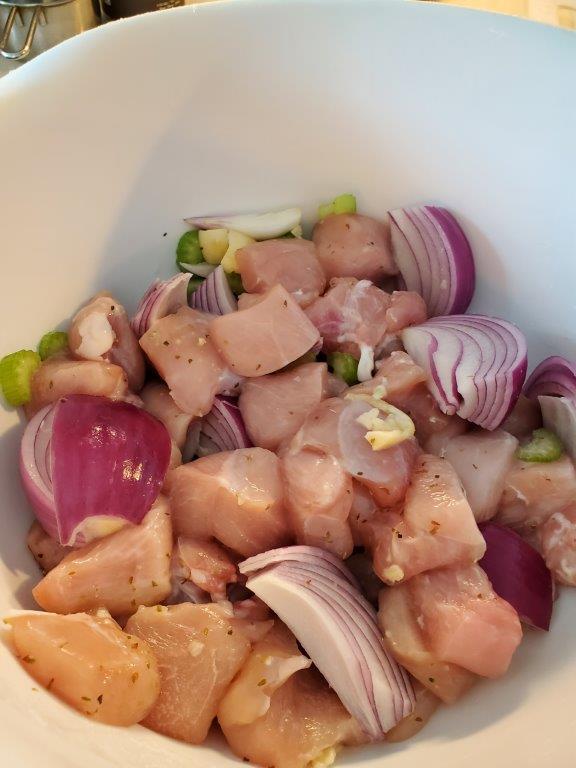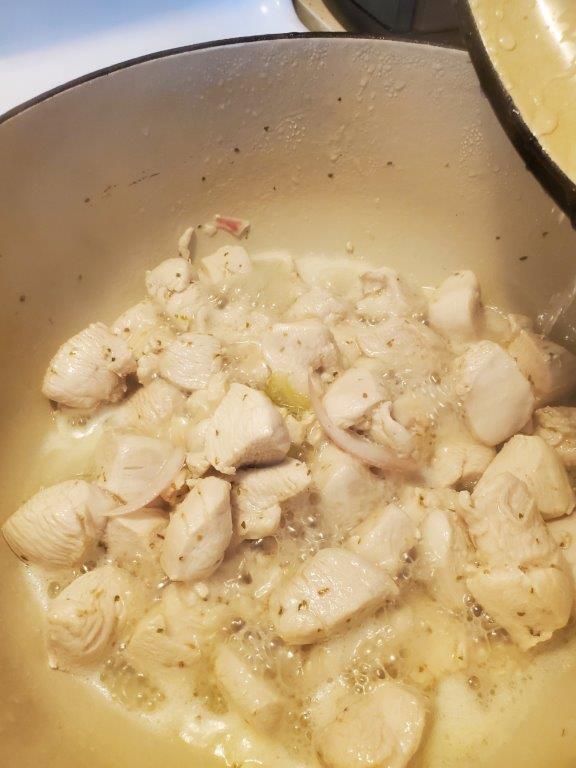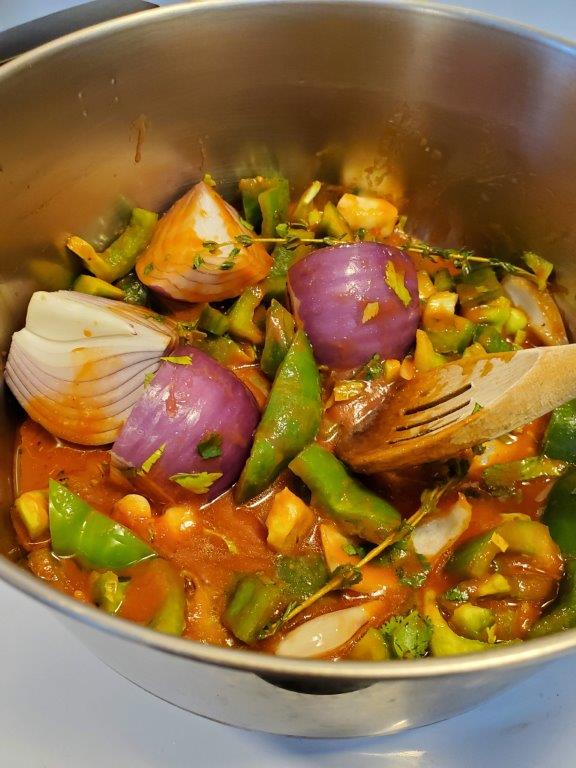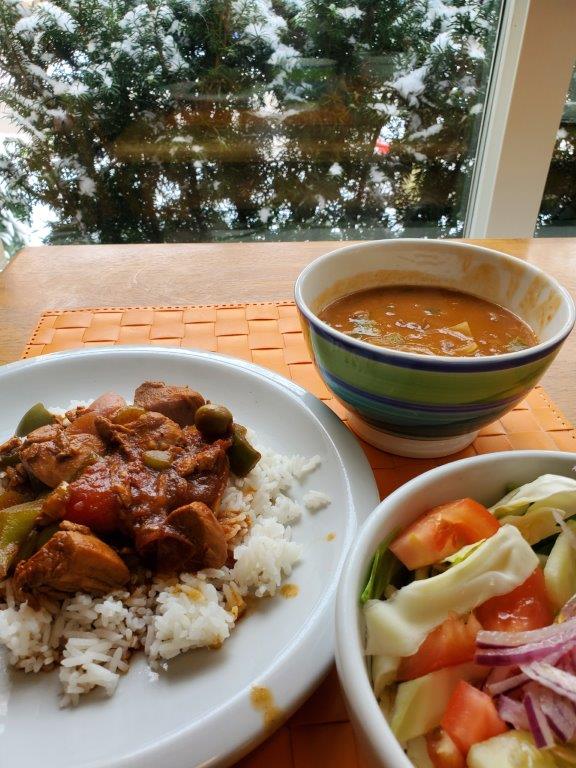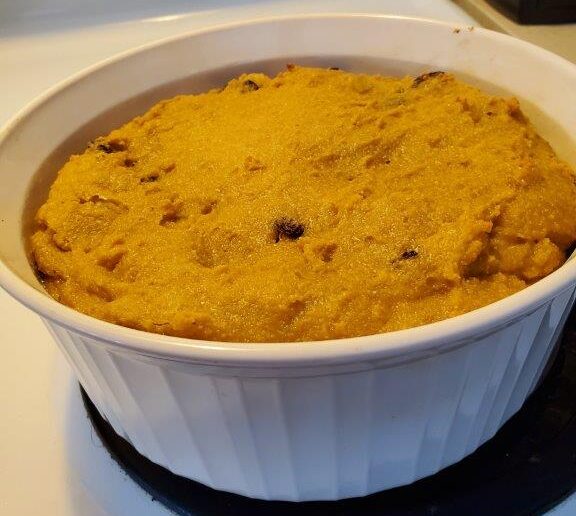Last week we made our best guess at a meal favored by DomiNEEcans, so this week, let’s see what we can manage for the DoMInicans, shall we? The Dominican Republic shares the island of Hispaniola with Haiti, the only island in the Caribbean to be split between two countries. (We are NOT getting into Guantanamo Bay right now.) It’s been an independent country since the 1860s, although that hasn’t stopped the US from doing lots of awful things to it since then.
There’s lots of resources for Dominican food online, and we chose to make the country’s national lunch dish “La Bandera.” Literally translated as “The Flag,” this dish features rice, beans, and some sort of meat stew representing the three colors of the Dominican flag. The rice represents white. The beans represent red. The third color in the Dominican flag is blue.
Um.
There’s lots of handwaving on this point on the web:
We’re going to do our best here to ensure that blue remains a FIGURATIVE attribute of the meat portion of this dish.
So let’s get started. We’ve chosen to go with chicken for our stew, but beef would also be appropriate. The chicken is first marinated with a blend of onions, garlic, lime juice, and seasonings Whole chicken parts on the bone would probably be more authentic, (as well as including the more challenging bits) but we decided to lazy out this time and just get boneless breasts.
After a soak in the fridge, you brown a little sugar in oil in the pot. This didn’t seem to do much at first, since it wasn’t that much sugar. We picked the chicken parts out of the marinade, leaving the vegetables behind, seared the meat a bit, and then left it to braise for 15 minutes.
You’re supposed to keep putting in just enough water so it doesn’t burn. Like, a tablespoon at a time. We mostly kept an eye on it, but with the lid closed, it was easy to miss that it had boiled off until it started to smell a little burny at 15 minutes. I quickly poured in some more water….
…and that’s when the goddamned alchemy happened. After fifteen minutes of braising, the chicken was the same color as the picture above. Pour in half a cup of water at that point, and everything hissed, and suddenly:
It literally turned that color in under five seconds. I think we had caught it just in time, so that the sugar was cooking on the bottom of the pot, but hadn’t quite burned. Just witchcraft, I tell you.
Well, with that, it was time to toss in our marinade vegetables, along with some friends, and let the whole thing cook down a bit more with some tomato sauce.
So now lets jump back a bit in time and talk about the beans, which we were cooking at the same time. (Which may have been how the chicken got away from us.) We decided to use pinto beans, although pigeon peas are apparently also quite common. The Instant Pot once again proved miraculous for its bean-cooking abilities. We would definitely consume fewer legumes without some sort of pressure cooker.
The recipe for this one is a pretty standard stewed beans procedure: sweat some aromatics, then dump in the beans with their water, and let them boil until soft.
Seasonings were onion, garlic, thyme, cilantro, and a new one on us: celery leaves rather than stalks. It didn’t seem to really add much one way or the other.
Finally, we were assured that this meal was always accompanied by a salad, so we made a quick one with cabbage, tomatoes, cucumbers, and onions. Here’s the whole package, with some fresh Vancouver snow to really accentuate the tropical meal.
And it was pretty tasty! The chicken, in particular, had a LOVELY flavor from the caramelized sugar. The beans were fine, if not terribly exciting. However, this raises a point – when we make these meals, we try not to put in a lot of extra condiments on the first bash through, so we can appreciate the food directly. BUT – is that authentic? Would Dominicans be donking hot sauce into these beans? I honestly don’t know.
I can GUARANTEE that a heaping teaspoon of Spicy Chili Crisp is NOT authentic, but when we used it in the leftovers the next day, it sure did work. By the way, if you haven’t already, get you some Spicy Chili Crisp. Good stuff.
Finally, it was time for dessert. We decided to go with an Arepa, or cornmeal cake. The Dominican version we chose used cornmeal, coconut and regular milk, brown sugar, and raisins. No raising agents at all, so a very dense bake. It is apparently often baked in a pot with a rounded bottom, to give a dome shape when turned out. We used a ceramic baking dish we had handy.
And turned out, it looked pretty good. It was VERY tasty, especially with coffee or hot chocolate to cut the richness. Since the lunch was very filling, we waited a few hours to cut a few slices.
This was delicious, and served well as both breakfast and snack for the next several days, given that there are only the two of us.
So, Dominican Republic – nice job! We appreciate your food, and the incredible color changing stew.
And that completes the “D”s! Next week, we will PROBABLY do the southeast Asian country of East Timor, unless we decide to file that one under “T”. Never a dull moment!
Recipes:
La Bandera Dominica
Dominican Arepa

